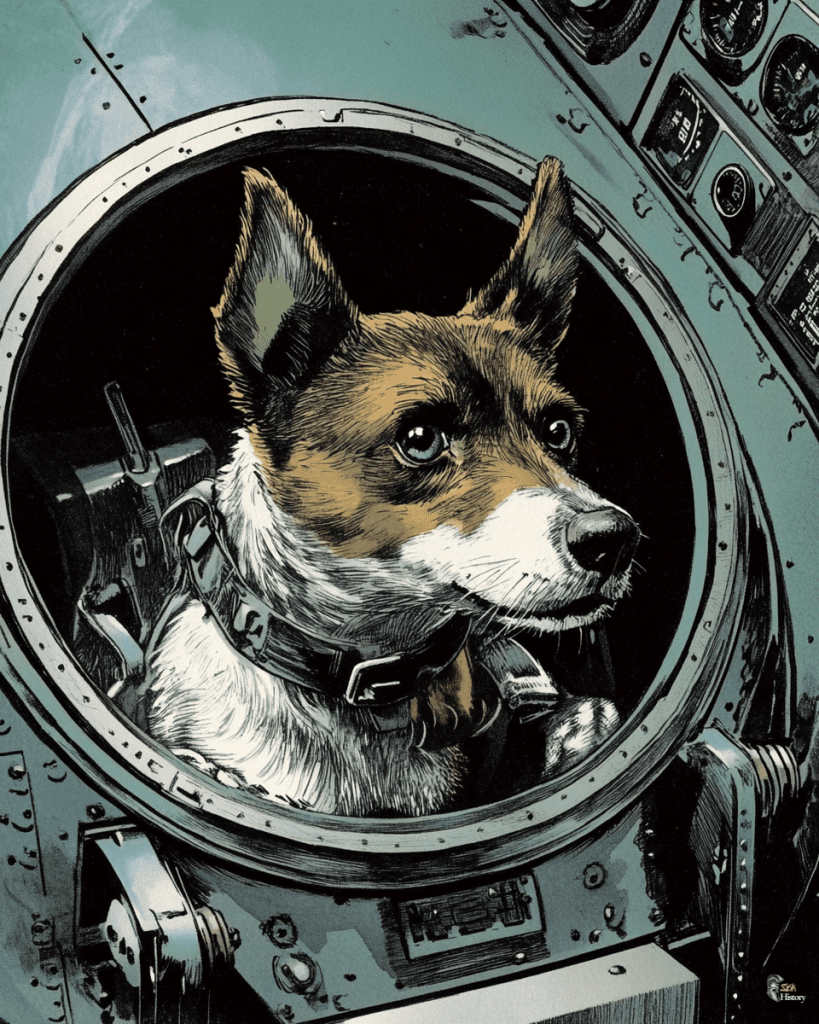On November 3, 1957, a small stray dog named Laika made history as the first animal to orbit Earth. Launched aboard Sputnik 2, her journey marked a significant milestone in the Cold War space race between the Soviet Union and the United States.
While Laika’s mission was groundbreaking for space exploration, it sparked intense debates about the ethics of animal experimentation in scientific research.
Laika’s story captivated the world, symbolizing early space exploration’s triumphs and moral dilemmas. The Soviet canine cosmonaut faced extreme conditions during her one-way mission, enduring g-forces five times normal gravity levels at launch.
Her sacrifice paved the way for human spaceflight but also raised questions about the cost of scientific progress.
The Sputnik 2 mission came just one month after the successful launch of Sputnik 1, demonstrating the rapid advancements in space technology during this era.
Laika’s flight provided valuable data on the effects of spaceflight on living organisms, contributing to the field of space biology.
Journey to the Stars: Laika and the Soviet Space Program
The Soviet space program’s pioneering efforts in the 1950s captured global attention. The launch of Laika aboard Sputnik 2 marked a significant milestone in space exploration. This mission pushed the boundaries of science and raised important ethical questions about animal experimentation in space.
Laika, the Canine Cosmonaut
Laika, a stray dog from Moscow, became an unlikely hero of the Soviet space program. She was selected for her calm temperament and small size and underwent rigorous training to prepare for her historic flight.
Soviet scientists chose her as the first living creature to orbit Earth, paving the way for human spaceflight.
Laika’s story captivated the public imagination and provoked debate about the ethics of using animals in scientific research.
Sputnik 2 Mission: A Leap into the Unknown
On November 3, 1957, Sputnik 2 launched with Laika aboard, marking a significant achievement in space exploration. The mission aimed to study the effects of spaceflight on living organisms, gathering crucial data for future human missions.
The spacecraft orbited Earth, reaching speeds of 18,000 mph.
Despite the mission’s scientific success, it ended tragically for Laika. The technology for safe re-entry had not yet been developed, making her journey a one-way trip.
Sputnik 2’s success demonstrated the Soviet Union’s technological prowess and intensified the space race with the United States.
Space Race and Ethical Reflections
The Space Race of the 1950s and 60s brought unprecedented scientific advancements, but also raised serious ethical questions. The use of animals in space missions, particularly the story of Laika, sparked debates about the moral costs of progress and the treatment of living creatures in scientific pursuits.
Ethics of Animal Experimentation in Space
The Soviet Union’s decision to send Laika into space on Sputnik 2 in 1957 marked a significant milestone in space exploration.
Laika, a stray dog from Moscow, became an unwitting pioneer in a one-way mission that ultimately led to her death.
Critics argued that subjecting animals to such experiments was cruel and unnecessary. Supporters, on the other hand, claimed these sacrifices were essential for advancing human knowledge and paving the way for manned space flights.
Public Reaction to Animal Spaceflight
Laika’s journey into space captured the world’s imagination and sparked many emotions. Many were in awe of the scientific achievement, while others felt deep sympathy for the dog’s fate. The Soviet Union initially claimed Laika survived for several days in orbit, but it was later revealed she died within hours of launch due to overheating and stress.
This revelation led to widespread public outcry and increased scrutiny of animal testing in space programs. Animal rights activists protested against such practices, arguing that animals should not be sacrificed for human ambitions.
Ethical Debates in Science and Progress
The use of animals in space exploration encouraged broader discussions about the ethics of scientific progress.
Scientists and ethicists grappled with questions of whether the potential benefits to humanity justified the suffering of animals.
These debates extended beyond space exploration to other areas of scientific research involving animal testing.
Some argued that animal experimentation was necessary for advancing human knowledge and safety in space.
Others proposed alternative methods, such as more advanced simulations or robotic missions.
The controversy surrounding Laika and other animals in space contributed to developing stricter ethical guidelines in scientific research.

